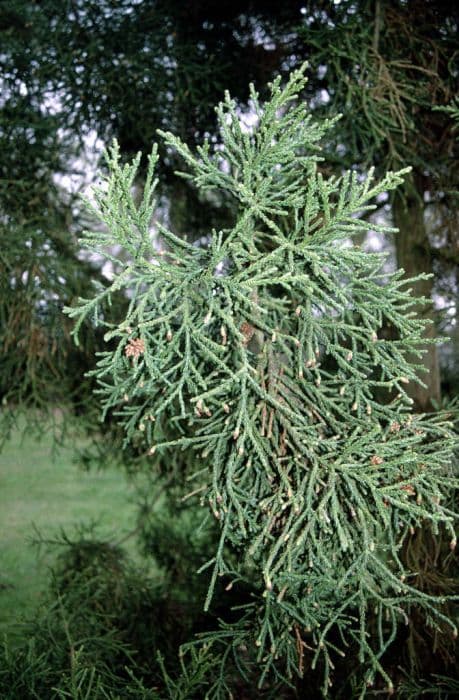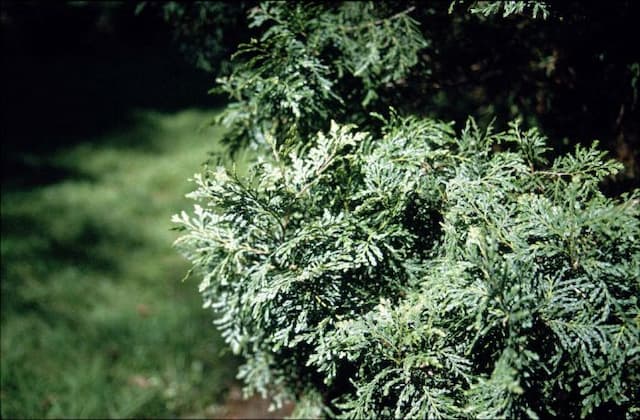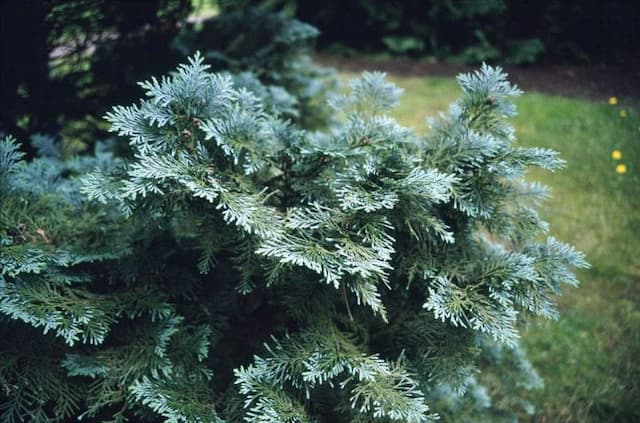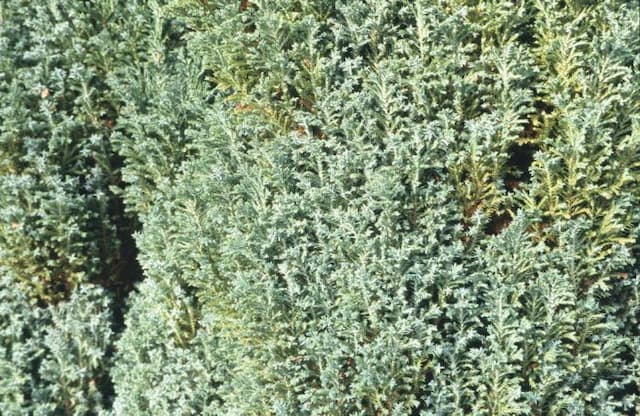Japanese Cedar Cryptomeria japonica 'Spiralis'

ABOUT
Cryptomeria japonica 'Spiralis', commonly known as Japanese cedar, is a unique conifer renowned for its distinctive appearance. The foliage has a rich, deep green color, which forms spiraling patterns along the branches, lending the cultivar its name 'Spiralis'. These needles are soft to the touch, unlike many of their sharper needled conifer cousins. The spiraled arrangement of the needles adds a textural and visual interest which changes throughout the growing season, from brighter greens in spring to darker, more mature hues as the seasons progress. As the tree matures, the bark becomes quite prominent, with an attractive reddish-brown color that peels away in strips, adding further interest to the plant's appearance. This peeling characteristic contributes to the Japanese cedar's reputation as a tree with year-round ornamental value. The overall shape of the tree is pyramidal, with a dense growth habit that can be almost columnar in form, making it a common choice for a focal point in gardens. During the winter months, the foliage might take on a bronze tint, which further enhances its winter appeal. The cones of the Japanese cedar are small and globular, adding yet another layer of texture to the plant with their woody, slightly spiky appearance. These cones typically form in clusters at the end of the branches, subtly concealed amidst the dense foliage.
About this plant
 Names
NamesFamily
Cupressaceae
Synonyms
Japanese Cedar, Japa Spiralis, Peabody's Plant
Common names
Cryptomeria japonica 'Spiralis'.
 Toxicity
ToxicityTo humans
Japanese Cedar generally is not toxic to humans and does not commonly cause poisoning if ingested. There are no significant toxic effects known for Cryptomeria japonica 'Spiralis' upon ingestion by humans.
To pets
The Japanese Cedar is not known to be toxic to pets. Ingesting parts of the plant should not result in poisoning or cause serious symptoms in animals such as dogs and cats. However, it is always best to prevent pets from eating plants as individual animals may have unique sensitivities or allergic reactions.
 Characteristics
CharacteristicsLife cycle
Perennials
Foliage type
Evergreen
Color of leaves
Green
Height
15-20 feet (4.5-6 meters)
Spread
5-10 feet (1.5-3 meters)
Plant type
Tree
Hardiness zones
5-9
Native area
Japan
Benefits
 General Benefits
General Benefits- Ornamental Value: Cryptomeria japonica 'Spiralis', commonly known as Japanese Cedar, has a unique spiraling growth pattern that adds visual interest to landscapes.
- Evergreen Foliage: It retains its rich green foliage year-round, providing consistent color and texture in garden spaces.
- Drought Resistance: Once established, it is relatively drought tolerant, reducing the need for frequent watering.
- Cold Hardiness: It can withstand cold temperatures, making it suitable for a variety of climates.
- Low Maintenance: Japanese Cedar requires minimal pruning and is generally low maintenance.
- Habitat for Wildlife: It offers habitat and protection for birds and other wildlife within its dense foliage.
- Soil Erosion Control: The root system can help stabilize soil and control erosion on slopes or in areas prone to soil loss.
- Privacy Screen: With its dense growth, it can serve as an effective privacy screen or windbreak in landscaping design.
- Shade Production: Japanese Cedar can provide ample shade due to its size and foliage, making it a desirable tree for parks and large gardens.
 Medical Properties
Medical PropertiesThis plant is not used for medical purposes.
 Air-purifying Qualities
Air-purifying QualitiesThis plant is not specifically known for air purifying qualities.
 Other Uses
Other Uses- Cryptomeria japonica 'Spiralis', commonly known as Japanese cedar, can be used in bonsai cultivation due to its interesting spiral foliage and the ability to be trained into miniature landscapes.
- The wood of Japanese cedar is resistant to rot and used in the construction of traditional Japanese homes, shrines, and temples because of its durability and pleasant scent.
- The fine-grained wood of the Japanese cedar is utilized in making furniture, and its unique grain pattern is especially valued for decorative pieces.
- Japanese cedar's dense foliage can provide effective sound barriers when planted in rows, reducing noise pollution in urban and suburban settings.
- This plant's wood shavings and sawdust are employed in making aromatic sachets and potpourris, which are placed in drawers and closets for a natural fresh scent.
- Wood from Japanese cedar is often used in the production of traditional Japanese instruments like the koto due to its acoustic properties.
- The foliage and small branches of Japanese cedar can be used in floral arrangements, particularly in ikebana, the art of Japanese flower arranging.
- Japanese cedar can be used as a natural dye source, with different parts of the plant producing various colors when processed correctly.
- Cultivars of the Japanese cedar, such as 'Spiralis', are cultivated for ornamental use in gardens and parks, where they add architectural interest due to their unique growth patterns.
- Wood from Japanese cedar is utilized in crafting washi paper, which is a traditional Japanese hand-made paper known for its strength and translucence.
Interesting Facts
 Feng Shui
Feng ShuiThe Japanese Cedar is not used in Feng Shui practice.
 Zodiac Sign Compitability
Zodiac Sign CompitabilityThe Japanese Cedar is not used in astrology practice.
 Plant Symbolism
Plant Symbolism- Longevity and Permanence: Cryptomeria japonica, commonly known as Japanese Cedar, is highly revered in Japan and symbolizes longevity due to its ability to live for hundreds or even thousands of years.
- Endurance and Strength: The tree's impressive height and sturdiness also represent endurance and strength, reflecting the ability to withstand the test of time and the elements.
- Sanctity and Sacredness: Japanese Cedar is often found in temple gardens and graveyards in Japan, signifying its sacred nature and use in purification rituals.
- Peace and Tranquility: The evergreen nature of the Japanese Cedar and its presence in serene temple settings lend it symbolic meaning for peace and tranquility.
 Water
WaterThe Japanese Cedar should be watered deeply and thoroughly, allowing the soil to dry out slightly between waterings to encourage healthy root growth. In general, providing about 1.5 to 2 gallons per week should be adequate, but this amount can vary based on weather conditions and soil type. During the growing season in spring and summer, you may need to water the tree more frequently, especially if there are extended periods of hot, dry weather. In contrast, reduce watering in the fall and winter when the tree's growth slows down. It's important not to overwater as this can lead to root rot.
 Light
LightThe Japanese Cedar thrives in full sun to partial shade, so it's best to plant it in a spot where it will receive at least four hours of direct sunlight daily. However, in particularly hot climates, some afternoon shade can be beneficial to prevent scorching. The plant's unique spiraled foliage displays best when it receives ample light. Avoid deep shade as it can lead to sparse growth and a less dense habit.
 Temperature
TemperatureThe Japanese Cedar is hardy and can withstand a range of temperatures; however, it thrives in temperatures between 60 to 80 degrees Fahrenheit. It can survive minimum temperatures down to about -20 degrees Fahrenheit, but it may need protection from harsh winter winds. The ideal temperature range for this plant is moderate, ensuring that its foliage remains healthy and vibrant throughout the seasons.
 Pruning
PruningThe Japanese Cedar typically does not require regular pruning due to its natural growth habit, but it may benefit from occasional shaping or removal of dead and damaged branches. The best time to prune is in late winter or early spring before new growth starts. Pruning too often or too late in the season can inhibit the development of its distinctive spiral foliage.
 Cleaning
CleaningNot needed
 Soil
SoilThe Japanese Cedar 'Spiralis' prefers a well-draining soil mix, rich in organic matter, with a pH ranging from slightly acidic to neutral (pH 5.0-7.0). A blend of two parts loam, one part peat moss, and one part sharp sand or perlite is ideal for ensuring good drainage and aeration.
 Repotting
RepottingJapanese Cedar 'Spiralis' should be repotted every 2-3 years, when its growth begins to slow down due to root crowding. Younger plants may require more frequent repotting, whereas mature specimens can be repotted less often.
 Humidity & Misting
Humidity & MistingJapanese Cedar 'Spiralis' does well in moderate to high humidity levels. It thrives when the humidity is around 50-70% which is typical of an outdoor environment in its native habitat or in a temperate greenhouse.
 Suitable locations
Suitable locationsIndoor
Place in bright light, avoid direct sun, ensure ample space.
Outdoor
Full sun to partial shade, shelter from harsh winds.
Hardiness zone
5-8 USDA
 Life cycle
Life cycleThe life of Cryptomeria japonica 'Spiralis', commonly known as Japanese cedar 'Spiralis', begins with seed germination, typically in moist, well-drained soil under partial shade to full sun. After germination, the seedling stage involves the establishment of roots and initial shoot growth. As the plant matures into the sapling stage, it develops its characteristic spirally arranged foliage, with the bark and branches thickening over time. The Japanese cedar 'Spiralis' reaches reproductive maturity after several years, producing male and female cones on the same tree; male cones release pollen while female cones develop seeds. The mature tree stage can last for many years, with the tree continuing to grow in height and diameter while maintaining its health through proper care and environmental conditions. The plant eventually enters the senescence stage, where growth slows and the tree may become more susceptible to diseases or environmental stress before ultimately dying.
 Propogation
PropogationPropogation time
Early spring
The Japanese cedar, more specifically Cryptomeria japonica 'Spiralis', is commonly propagated through the use of semi-hardwood cuttings. This method involves taking cuttings from the semi-hardwood portion of the plant, which is the current year's growth that has started to mature and toughen up but hasn't yet become fully hardened, typically in late summer or early fall. The cuttings, usually around 4 to 6 inches (10 to 15 centimeters) in length, should include at least one or two sets of leaves. They need to be treated with a rooting hormone before being planted in a well-draining soil mix, kept moist and under a controlled environment, with the use of mist systems or plastic coverings to maintain high humidity. Successful rooting can take several weeks, after which the rooted cuttings can be gradually acclimatized to less humid conditions before being transplanted to their final location.









